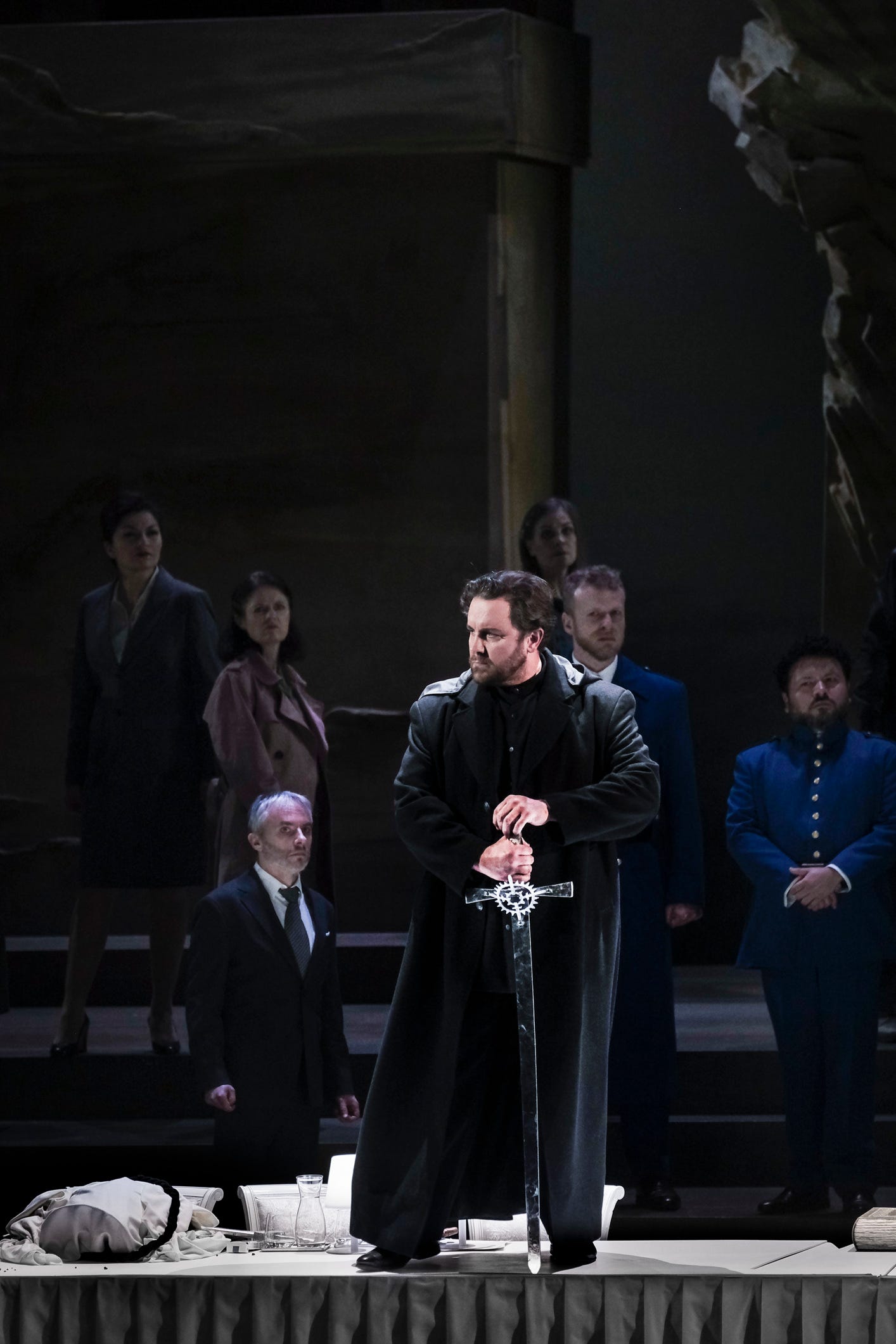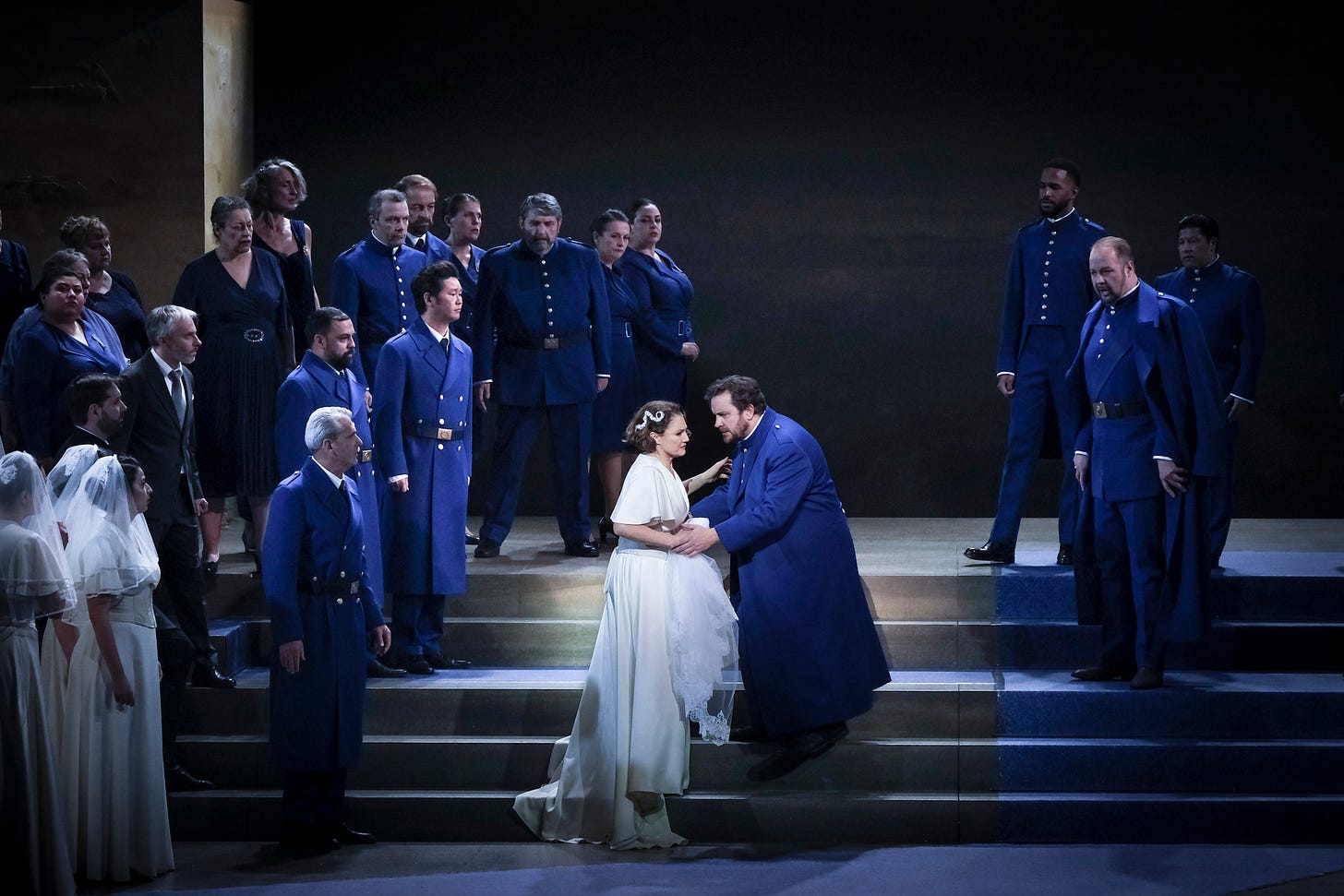Michael Spyres (Lohengrin) Picture by Klara Beck
This review first appeared in Jan Geisbusch’s German translation on Oper! Magazin’s website. The original English version is republished here by kind permission of the editor, Dr Ulrich Ruhnke.
For quite some time now, the eye-wateringly versatile American Michael Spyres has been signalling a transition to heroic Wagnerian repertoire. This unclassifiable singer - a master of roles usually sung by tenors of quite different weight and vocal colour - has excelled in Baroque music (his next big recording project for Warner, Handel’s Jepththa), florid early Mozart, high-lying Italian and French Rossini and Donizetti, their Parisian contemporaries, Auber, Spontini, Meyerbeer. His journey towards Wagner was set out in his debut solo album, Baritenor, in which the French version of Lohengrin’s Récit du Graal featured, sung with the airy-grace and subtle use of head-voice, recalling a French Wagnerian of yore, Georges Thill, whose versions of ‘Aux lieux lointains’ and ‘Mon cygne aimé’ are early gramophone classics. In Spyres’ latest disc, ‘In the Shadows/Wagner’, Lohengrin’s famous ‘Grail Narration’ is sung in the original language, issued to mark his role début in the complete opera at Strasbourg’s Opéra du Rhin (First Night March 10).
As we might have expect expect from the discs, his Lohengrin is a unique account of the role, sung with a voice considerably lighter and more pliant than famous interpreters of the past, but with a darker timbre, suggesting heroic overtones. Judiciously, he chose to make his first appearance in a complete Wagner opera in a congenial, medium-sized house with the excellent Orchestre Philharmonique de Strasbourg and its chief conductor, Aziz Shokhakimov in the pit. Spyres knows this orchestra well through several Berlioz performances and recordings with John Nelson, including award-winning accounts of Les Troyens and La Damnation de Faust. At the Opéra here, he has sung a recital, but this is his stage debut
In a programme Interview, Shokhakimov dates his first encounter with the music Lohengrin to his teenage studies of the Acts 1 and. 3 preludes, when he was struck by the extraordinary palette of colours and sonorities of Wagner’s orchestration. He does not make cear that this Strasbourg production is his first encounter with the entire opera, but if so, it Is an estimable debut. From the opening bars of the score he evokes the spirituality of Monsalvat and the Guardians of the Grail in Wagner’s “halo” of divisi strings, played with shimmering ethereal translucence by the Strasbourg orchestra.
Wagner’s Macbeths: Josef Wagner (Telramund), Martina Serafin (Ortrud) Picture by Klara Beck
With the Opéra du Rhin team, Shokhakimov has assembled an exceptionally fine cast around Spyres’s titular hero: the rising South African soprano, Johanni van Oostrum. whose Elsa has already been heard at the Bayerische Staatsoper; the exceptional Austrian baritone, Josef Wagner, as a Telramund whose dark-timbre lyric voice as yet shows no sign of Wagnerian wear-and-tear; and the Finnish bass, Timo Riihonen, as King Heinrich recalling a young Matti Salminen, both in physical stature and beauty of tone. At a fairly late stage in the rehearsals, Austrian soprano, Martina Serafin, stepped in for the announced Anaïk Morel, as a charismatic Ortrud, with plenty of dramatic soprano heft for her summoning of the pagan gods at the end of her Act 2 confrontation of Elsa, but also the subtlety to bring dark humour to her sarcastic put-downs of her slow-witted husband.
If Spyres is the musical linchpin - one rarely hears Lohengrin’s part delivered with “bel canto” phrasing and such ringing high notes - then Serafin brings dramatic focus to a staging that suffers from some fuzzy, ill-thought-out ideas. Florent Siaud, the young French director, makes an uncertain Wagnerian debut with a Lohengrin whose visual imagery draws on a wide palette of references. The Kemenate of Antwerp, for example (Act 2) is a literal representation - sets by Romain Fabre - of a medieval castle, complete with watch-tower from which van Oostrum’s Elsa sings ‘Euch Lüften die mein Klagen’ with dreamily lovely tone. The costumes (Jean Daniel Vuillermez) suggest the interwar period of the 20th Century, the male uniforms perhaps more suitable to the militaires of Offenbach’s Gérolstein than Wagner’s Brabant.
Siaud certainly has ideas. During the prelude we see Elsa gazing at the stars, specifically at the constellation, Cygnus, through a telescope, giving her adolescent brother, Gottfried, a quick lesson in astronomy. Later when Lohengrin’s swan returns in Act 3, the constellation is projected onto the scenery, and at the end young Gottfried returns to his sister’s embrace, along with a small group of his playmates, delighted to see him back.
On the steps of the Münster: Johanni van Oostrum (Elsa), Michael Spyres (Lohengrin) Picture by Klara Beck
But his handling of the chorus looks like opera from a distant past - processional, pageant-like, not always punctiliously drilled. Even the principals have to endure some hoary business: during their brooding Act 2 encounter outside the walls of the Kemenate, Serafin’s Ortrud dismembers a dead raven as she hatches her dastardly plan to break the bond between Lohengrin and Elsa, destroying his Christian “magic” and their all-too-fragile love-at-first-sight affair. In Act 3, another deceased black bird crashes down from the flies at Ortrud’s feet, provoking unintended mirth in Strasbourg. For reasons of economy, I suspect, the unhappy couple’s post-wedding tryst took place not in a bedroom, but in a very public chapel illumined by votive lights, a Venus de Milo standing watch to suggest a hint of eroticism. Siaud makes much of Wagner’s interest in classical Greece to justify his directorial glosses, but they hardly add up to a production concept.
Witch at the Wedding: Serafin (Ortrud) confronts van Oostrum (Elsa) in Act Three Picture by Klara Beck
Luckily, Wagner’s music swept us up in a thrilling aural drama, indeed, Shokhakimov’s handling of the brassy triumphalism of the Act 3 prelude literally enveloped the audience with trumpets dotted around the auditorium. This was the orchestra’s first encounter with the score of Lohengrin for the best part of thirty years, but its playing here reminded us forcefully of Strasbourg’s past a German house with a strong Wagnerian tradition, fostered by Hans Pfitzner and Otto Klemperer among others.
As Spyres ventures into more Wagner territory - Siegmund at Bayreuth this summer, Stolzing in the festival’s next new Meistersinger (2025) - I hope he will have the chance to repeat his Lohengrin with a director whose vision of the opera is more compelling than Siaud’s. Anyone who was present, however, can be pleased to have attended this important Wagnerian debut.
Spyres’ new disc also contains the most liquidly sung account of Rienzi’s great prayer, Allmächt’ge Vater I have ever heard. With the third of Wagner’s early operas soon to enter the canon at Bayreuth, one might hope that Spyres is in pole position to sing the title role.
Further performance in Strasbourg, March 19 & 22, in Mulhouse April 7 & 10
Website operanationaldurhin.eu








Great review and so pleased to hear that the amazingly talented & versatile Spyres is moving so successfully into this repertoire. So looking forward to Jeptha and hope that it'll be another stellar collaboration with DiDonato
I'd be very interested to hear JDD singing 'Scenes of Horror! Scenes of Woe!' but je n'en sais rien, désolé 🤷🏻😂